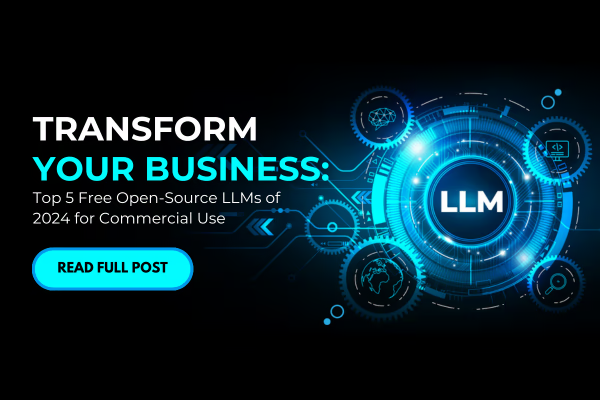Large Language Models (LLMs), are advanced Artificial Intelligence (AI) systems crafted to comprehend and generate human-like text. In the current competitive landscape, companies are seeking an edge through advanced technologies. Open-source LLMs offer a potent solution for commercial applications. From reshaping customer interactions via automation, content creation, and operational efficiency. From automating customer service to fueling marketing campaigns, LLMs empower companies to engage customers effectively, streamline operations, and foster innovation. Large Language Models (LLM) are the foundational models of widely used chatbots.
Open Source Large Language Models represent a paradigm shift in natural language processing (NLP), fostering collaboration and innovation. They provide accessible frameworks and data for developers to build innovative tools democratizing AI. By providing access to source code and pre-trained models openly, they mainly cultivate a diverse ecosystem of applications, research, and tools.
The transparent architecture encourages innovation, enabling researchers and developers to refine capabilities and improve model robustness. Open Source LLMs empower communities to tailor language technology to diverse needs, accelerating progress in fields like translation, summarization, and conversational AI. Through collective effort, they drive the advancement of AI for the benefit of all.
Let us get a deeper insight into the top 5 Open-source LLMs that any company can use for free.
Llama-3
This advanced model Llama-3 8B Gradient Instruct 1048k i.e., extends Llama-3 8B’s context length from 8k to over 1048k. This enhanced model depicts that SOTA LLMs can manage long contexts with minimal training effectively. Llama 3 is an openly accessible advanced model that excels at language difference, and contextual understanding and also performs complex tasks such as translation and dialogue generation. This model is a significant stride forward in AI technology.
Technology Complexity
The Llama 3 model is trained on two custom-built 24K GPU clusters on over 15T tokens of data- a training dataset that is 7x larger than that used for Llama 2, including 4x more code. This results in enhanced model performance that supports an 8k context length which is double of Llama 2.
Llama-3 increases context lengths, drawing on techniques like NTK-aware interpolation and Ring Attention for efficient scaling. This results in a massive increase in training speed, making the model powerful enough to handle extensive data.
Also, this can handle multi-tasks effortlessly, improving response alignment, and boosting diversity in model answers. This model also elevates capabilities such as reasoning, code generation, and more.
State-of-the-art performance
The new 8B and 70B parameter model is a major leap over Llama 2 and establishes a new state-of-the-art for LLM models. Improvement in pretraining and post-training have fine-tuned the models thus making them the best models existing today at 8B and 70B parameters scale. Improvement in the post-training procedure has substantially resulted in reduced false refusal rates, improved alignment, and increased diversity in responses.
Benchmark- Llama-3 is a cutting-edge LLM that is pushing the boundaries of technology proving to be a game-changer in different fields via innovative techniques and versatile applications.
BERT
Developed by Google, BERT (Bidirectional Encoder Representations from Transformers), is a transformer-based deep-learning model that is easy to understand and generates human-like language. BERT has been pivotal in advancing natural language processing tasks. It employs an encoder-only architecture. Before transformers were introduced, modeling natural language was a challenging task. It uses encoder-only architecture which suggests a primary emphasis on understanding input sequences rather than generating output sequences.
Technology complexity
The complexity of the BERT model lies in its ability to handle multiple language tasks effectively. Here’s a concise overview:
- BERT serves as a versatile solution for more than 11 common language tasks, including sentiment analysis, named entity recognition, and text generation. BERT excels across various domains.
- BERT’s strength lies in its bidirectional understanding of context i.e., it considers both left and right context in all layers instead of analyzing the text sequentially.
- BERT’s success hinges on a massive pre-training dataset of 3.3 billion words. This enhanced training allows it to learn rich representations of language thus making it highly effective.
- BERT involves unsupervised pre-training followed by supervised fine-tuning for specific tasks. Once this is done, it can be shared and fine-tuned for various uses.
- BERT models are large and expensive. The memory footprint scales with input length which sets a limitation for users with limited computational resources.
BERT language model can be used for sentiment analysis, language translation, question answering, google search, text summarization, matching, retrieving text, and highlighting paragraphs.
CodeGen
CodeGen is an autoregressive language model for program synthesis developed by Salesforce AI Research i.e., trained sequentially on The Pile, BigQuery, and BigPython. The innovative CodeGen model is an exceptional creation that takes GPT-3.5 architecture to a new level. This has an impressive range of sizes i.e., 350 million, 2 billion, 6 billion, and a colossal 16 billion parameters. CodeGen is an enhanced LLM that is believed to revolutionize the software development industry. These models are designed to generate code based on natural language prompts
The CodeGen training dataset is an extensive collection of code snippets from different programming languages and frameworks such as GitHub and Stack Overflow. With vast datasets, CodeGen usually understands the programming concepts and their natural language relationship which allows it to provide accurate and reliable code solutions with simple English inputs.
This is gaining popularity in the developer community as developers see full potential for streamlining software development processes. Integrating the use of CodeGen helps developers boost productivity, save time, and focus on more complex tasks.
Technology complexity
- CodeGen includes various variants such as CodeGen1 (released in March 2022), CodeGen2 (released in May 2023), and CodeGen2.5 (released in July 2023). These models range from 350M to 16B parameters.
- CodeGen’s primary purpose is program synthesis where it translates human-readable descriptions into executable code. For example, if we can input a prompt like “#this function prints happiness all around” CodeGen will generate the corresponding code.
- Due to strong infill sampling capabilities and technology involved, CodeGen 2.5 with only 7B parameters is more efficient and effective for code generation tasks.
- CodeGen models are trained using the Jaxformer library, which handles data pre-processing, training, and fine-tuning.
One of the effective uses of CodeGen is speeding up design-to-code workflows. With CodeGen, designers can create mockups or wireframes, where CodeGen can translate their English descriptions into functional Python code.
For instance, if a UX designer specifies a button’s appearance and behavior, CodeGen can generate the corresponding code snippet. It will be like having an AI-powered assistant that understands design intent and produces the code accordingly.
GPT-NeoX and GPT-J
GPT-NeoX and GPT-J are two advanced open-source LLMs that are alternatives to GPT. These language models can perform various natural language processing tasks such as text generation, sentiment analysis, research, and development of marketing campaigns.
GPT-Neox has 20 billion parameters, whereas GPT-J has 6 billion parameters. Advanced LLMs can be trained with over 100 billion parameters resulting in providing highly accurate results. These are trained with 22 high-quality datasets making them reliable and suitable for use in multiple domains. These are free open-source LLM which are available via NLP Cloud API.
Technology Complexity
GPT-NeoX:
- GPT-NeoX computes attention and feedforward neural networks in parallel, enhancing efficiency. It also employs rotary position embeddings for better positional information injection.
- GPT-NeoX uses dense attention instead of sparse attention.
- GPT-NeoX has a vocabulary size of 50257 tokens and a context window of 2048 tokens.
- The technology used is mainly integrated for large-scale language modeling tasks, bridging design and development, and more.
GPT-J:
- GPT-J is an autoregressive, decoder-only transformer model that works on predicting how text will continue based on preceding tokens.
- GPT-J uses parallel computation, rotary position embeddings, and dense attention. It has 28 transformer layers and 16 attention heads.
Commercial use
Let us have an overview of how GPT-NeoX and GPT-J can be used commercially:
GPT-NeoX:
- GPT-NeoX’s large parameter count makes it best for managing complex language tasks, such as chatbots, content generation, and sentiment analysis.
- Companies can also deploy GPT-NeoX to handle customer inquiries, providing quick and accurate responses.
- Companies can customize GPT-NeoX to make it put into use for specific domains, like legal or medical text analysis.
GPT-J:
- GPT-J excels in creating natural language text, making it valuable for content creation, marketing, and storytelling.
- Developers can use GPT-J to generate code snippets, aiding software development.
- GPT-J can enhance multilingual communication in global markets.
Vicuna 13-B
Vicuna-13B, an open-source chatbot fine-tuned using the LLaMA 13B model. This was developed by training LLaMA-13B using ShareGPT. This is very useful for companies who are looking to automate their customer service operations as it excels in chat-based applications, providing accurate and contextually appropriate responses.
Vicuna 13-B can be used in different industries such as healthcare, education, finance, travel, hospitality, and more. Companies can use this LLM to create chatbots which are used to support customers and automate repetitive queries.
A real use case of this is Sephora, which uses chatbots to assist its customers in finding relevant products, checking their status, and getting tips from the website.
Technology complexity:
Let us understand the technology involved in Vicuna-13B:
- Vicuna-13B is trained using real multi-turn conversations collected from ShareGPT. This conversational data helps it handle chatbot interactions naturally.
- Preliminary evaluation with the integration of GPT-4 shows that Vicuna-13B achieves more than 90% quality compared to OpenAI ChatGPT and Google Bard.
Commercial use:
Vicuna-13B has some promising commercial uses:
- Healthcare Chatbots: Vicuna-13B can power conversational AI in healthcare. It assists patients, schedules appointments, and answers medical queries while maintaining privacy at all levels.
- Customer Support: Companies can deploy Vicuna-13B for efficient customer service. It has the strength to handle inquiries, troubleshoot issues, and provide personalized responses.
- Content Generation: Vicuna-13B can also create blog posts, marketing copy, and social media content, saving time for businesses.
- Legal and Financial Services: Vicuna-13B aids in drafting legal documents, contracts, and financial reports.
Use-cases of Open-Source LLMs
Open-source Large Language Models (LLMs) have enhanced productivity in companies by transforming the way businesses operate and engage with customers. Let us explore some of the diverse use cases of prominent open-source LLMs, including Llama 3, BERT, CodeGen, GPT-NeoX, and Vicuna-13B, across different sectors:
1- Customer Service and Support:
Industries such as retail, telecommunications, and finance, open-source LLMs like GPT-NeoX, BERT, and Vicuna-13B are revolutionizing customer service and support. These LLMs can analyze customer queries in real-time, understand context, and provide personalized responses, thus offering accurate and prompt assistance. By automating repetitive inquiries and troubleshooting tasks, businesses can enhance customer experience by reducing response time.
2- Content Creation:
LLMs such as GPT-NeoX and Vicuna-13B are effectively used for content creation. They can generate high-quality, engaging content for websites, social media, and advertisements. By leveraging these open-source LLMs, businesses can produce relevant, timely content at scale, thereby increasing customer engagement, brand awareness, and lead generation.
3- Software development and coding:
Open-source LLMs like CodeGen are helping engineers speed up the design-to-code workflows. CodeGen is specifically designed for software development tasks, such as code generation, auto-completion, and bug detection. This assists developers in writing efficient code, debugging programs, and accelerating the software development process. With CodeGen, designers can create mockups or wireframes, where CodeGen can translate their English descriptions into functional Python code.
4- Financial Analysis and risk management:
Open-source LLMs such as BERT and GPT-NeoX can be used in financial analysis for tasks like sentiment analysis, fraud detection, and customer support. These models can analyze vast amounts of financial data, detect anomalies, and provide insights to improve decision-making and risk management.
5- Healthcare:
Open-source LLMs like Llama 3 and GPT-NeoX hold the ability for medical research, diagnosis, and patient care. Vicuna-13B can power conversational AI in healthcare, assisting patients, scheduling appointments, and answering medical queries while maintaining privacy at all levels. By leveraging open LLMs, healthcare providers can improve clinical decision-making, personalize patient care, and advance medical research.
Companies can deploy Llama 3 to create chatbots and virtual assistants capable of handling complex customer queries and providing personalized support.
Performance Comparison
Evaluating the performance of open-source Large Language Models (LLMs) is entirely based on metrics such as accuracy, efficiency, and versatility across different use cases.
Among the open-source LLMs mentioned, BERT stands out for its strong performance in natural language understanding tasks, particularly in contextual word embeddings.
Following closely is GPT-NeoX, known for its impressive text generation capabilities and adaptability to various language tasks. CodeGen excels in software development tasks, providing valuable assistance to developers in code generation and debugging.
Llama 3 showcases promising potential, especially in customer service and support applications, with its ability to analyze queries and provide personalized responses.
Lastly, Vicuna-13B demonstrates proficiency in conversational AI applications, particularly in the healthcare sector, with its ability to assist patients and maintain privacy.
Overall, while each model has its strengths, their ranking depends on the specific requirements and objectives of the tasks they are deployed for.
Conclusion:
Open-source LLMs are powerful tools that are evolving rapidly and expanding fast. They are key in pushing natural language processing forward. They spark innovation which is further used and enhanced by companies for progressing in various fields by bringing transparency to AI development and fostering global collaboration.




